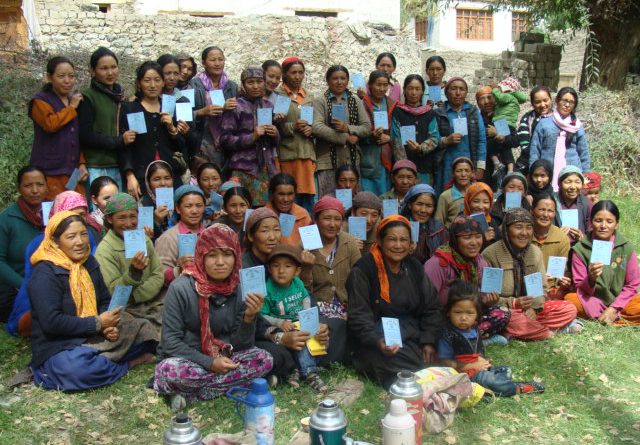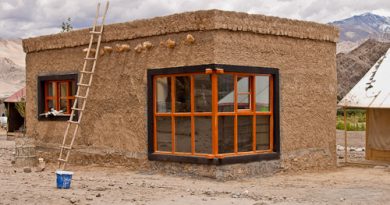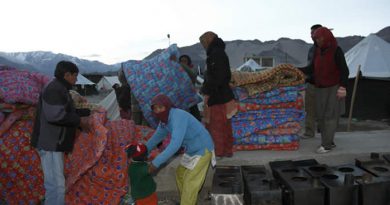LEARNING INCOME GENERATION IN THE HIMALAYAS TOGETHER (LIGHT)
LEDeG, in collaboration with GERES, is implementing project LIGHT. The project has different components and LEDeG, along with other local NGOs part of the network, is responsible for the implementation of the activities in different project areas across Ladakh. The project aims at improving the livelihood of the rural population in the Indian Western Himalayas consisting of Ladakh and parts of Himachal Pradesh.
Year:
2006-2009
Objectives:
- To set up additional income generation activities.
- To empower rural women.
- To improve the villagers’ health.
- To build the capacities of local NGOs.
Component I: Fruit Processing
Value addition of horticulture products, available in the low lying Sham area of Ladakh, has added another dimension to the rural economy. Owing to the inflow of tourists, the demand for such products is ever increasing. The fruit processing activities are primarily aimed at providing extra income for the women along with promotion of local products. Efforts are also being made to explore new markets outside Ladakh.
Target Group:
Women SHGs
Objectives:
- To enable SHGs on technical process, marketing, eco-finance and to help them to insert in sustainable product channel.
- To create income for villagers, in particular for women.
- To strengthen SHGs, give them self-confidence and impulse social innovative dynamic.
Activities:
- Training and Capacity Building
- Production
- Marketing
Activities Accomplished till the end of 2008:
- Technical inputs on value addition of horticulture products (Apricot and Seabuckthorn).
- Training on marketing of the products.
- Exposure visits for SHG women.
- Training on tools of business management.
- Construction of work-shed and purchase of machinery at Leih-do.
- Initiated the process of acquiring FPO license for Leih-do.
- Media tool: Technical Posters on Processing: Apricot Jam and SBT Juice processing, Booklet on Guidelines for FPO License.
- Marketing of products (Apricot Jam) at Dharamshala.
- Sale of products through the Crafts Centre at LEDeG, general stores in the local market, guesthouses and hotels in and around Leh and through exhibitions in different parts of India.
Component II: Wool Transformation
Livestock rearing is one of the primary occupations in the high altitude areas of Ladakh. Different kinds of wool are available: yak and goat wool in the highest parts and sheep wool elsewhere. Every ladakhi family, traditionally, transforms the wool into different items including clothes, carpets, shoes, blankets as well as tents. Apart from that, Pashmina is the main resource of the livestock rearing population, especially in Changthang, where the finest quality of Pashmina is produced. The wool transformation component of the project aims at value addition of the local wool based products.
Project Areas:
Leh District: Fanjilla, Rely Eaching, Hanupatta
Kargil District: Purkitse, Kartsekhar, Shagmakarpo,Rangdum,Juldoh,Rantaksha,Gyapak,Padum,Kisharak,Karsha,Pidmoo.
Objectives:
- The project aims at developing wool transformation as an income generating and women empowering activity.
- To support Women Self Help Groups (SHGs), paying particular attention to enabling the women to control the whole channel, from raw material purchasing to production and marketing, in order to ensure the sustainability of the activity after the project ends.
Activities:
The projects support the SHGs in the different dimensions of the activity:
- Activity management: Groups are trained to plan their production and record their income and expenditure (simplified accounts), so that they can plan their future investments (raw material, tools purchasing…)
- Technical skills improvement: Technical trainings are provided to the groups, according to their needs (knitting, natural dyeing, weaving, tailoring…)
- Appropriate technology: To lighten some of the transformation tasks and reduce the time required, appropriate techniques are proposed and trainings provided e.g. Carding machines, spinning wheels, frame looms.
- Micro-credit: If required, during the first years of the activity, the project provides loans to the groups, as revolving fund. To facilitate the investment in tools, it proposes the payment in different instalments.
- Marketing: SHGs market their products locally, to villagers or tourists, either by themselves or through a shopkeeper. Marketing tools are developed, and linkages with shopkeepers or other buyers are created.
Activities Accomplished\Undertaken till the end of 2008:
- Fanjilla: Training on Thikma dyeing (tie and dye)
- Refresher course on knitting
- Rely Eaching: Refresher course on knitting
- Kargil: Purkitse and Kartsekhar: Meeting for winter
- Pokar Phoo: Future plan for wool transformation
- Fangilla: Follow up of winter production
- Implementation of spinning and carding by different machines powered by Micro- Hydro for SHGs as they are the main potential users of the machines
- Hanupatta: Discussion about management of self help groups and wool transformation under the new project of income generation programme
- SHGs meeting at LEDeG on experience sharing of women on wool transformation.
- Coordinator meeting at LNP on wool transformation.
Component III: Improved Green House
The harsh winter condition of Ladakh does not allow vegetables to be grown in open fields during the winter months. And during the short summer months when production is possible, the local vegetable sellers have to compete with vegetables transported from the Indian plains. During the winter months, due to scarcity of fresh vegetables, vegetables have to be air lifted which come for triple the price. However, such facilities are absent in the more geographically remote areas. Improved Green Houses make it possible to grow vegetables even during the winter months. Some new and essential techniques to create a design adaptable to the area, keeping in mind cost-efficiency and local material availability, have been developed. The resultant improved greenhouse is made of stones, bricks and wood, has a double wall filled with straw on three sides, roof, ventilators, and is covered on the South side by a transparent and UV resistant polysheet. Except the sheet, all materials used for the construction are available locally.
Year:
2005 – 2009
Project Area:
Khaltse, Durbuk, Kargil, Zanskar
Target group:
This project targets those families who potentially get more benefits from IGH: families depending mainly on agricultural income, i.e. active farmers who do not have any important alternative source of income as a government job.
Objectives:
- Enable families to construct and run an improved green-house.
- Train local masons to the construction technique.
- Produce fresh vegetables.
- Increase income of the owner’s family.
Result Details 2006 – 2008:
| Project Area | 2006 | 2007 | 2008 | Total |
| Khaltse | 4 | 14 | 18 | |
| Durbuk | ||||
| Kargil | 19 | 39 | 58 | |
| Zanskar | 12 | 41 | 14 | 67 |
Component IV: Lambing Shed
Project Area:
Durbuk
Component V: Poultry Farm
Project Areas:
Kargil and Zanskar
Component VI: Micro Hydro Power Units: Rural Electrification and End Use Machines
Remote in the Himalayan hills of the Jammu and Kashmir and Himachal Pradesh states, the valleys of these desert areas lie at more than 3000 m. During the harsh and long winter, the temperature frequently falls below -20°C. The villages are then isolated for more than six months per year, the access passes being closed because of the snow.
Traditionally, families rely essentially on agriculture and livestock rearing. But in the last 50 years, this region has been subject to a rapid and deep evolution, due to the massive arrival of army to control the disputed borders, the development of the administration and NGOs, and the aperture of the area to tourism.
The meager incomes the project is working in Leh district (Nubra, Sham, Chang Tang, Leh area), in Kargil district (Zanskar, Panikar, Sanku, Kargil), and in Jammu and Kashmir state. It is also implemented in Lahaul and Spiti district, and in Himachal Pradesh state, where conditions are similar to the ladakhi ones.
LEDeG participated in the project LIGHT as a resource NGO with other local partner organizations, both on the implementation and installation of MHPUs, and of End Use Machines. It also participated as a proximity NGO for about six villages in the project, less technically experienced, but who has built trustful relationship with community in its working area, take advantage of resource NGO’s expertise to implement the project.
Aims and Objectives:
The main objective was to assist the rural population to set up supplementary income generation activities in order to earn financial resources for the access to basic services.
Under the Income Generation component, the specific objectives were:
a) To promote the development of services or of income generation activities powered by micro-hydro units.
b) To enable the appropriation of end-use machines by target.
c) To build capacity of local NGOs (micro-enterprise, development support, IGA activities).
Activities completed till end of 2008:
Area: Khaltse, Nubra, Kharu, Zanskar.
Results: Installation of Micro Hydroelectric Power Units and End-user Machine in year 2006, 2007, 2008


